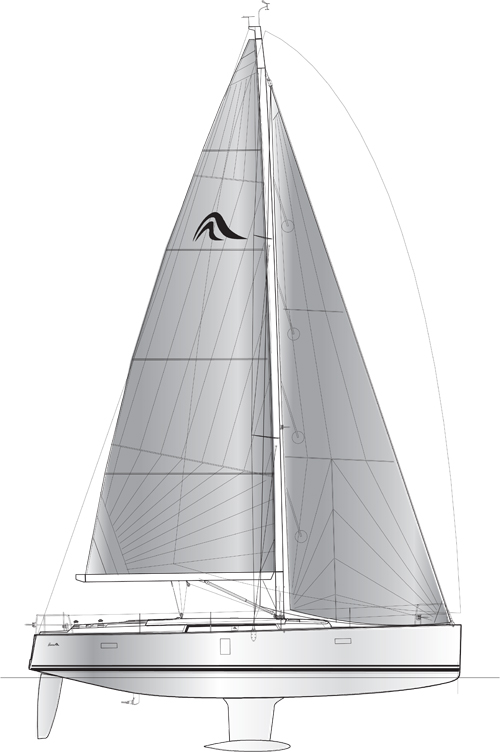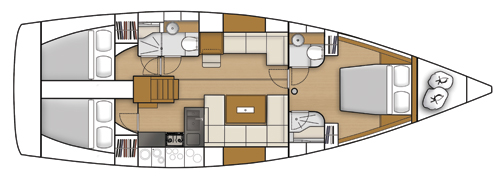Hanse 445 Cruiser
Here is another very contemporary design by Judel/Vrolijk for the Hanse line built in Germany. Looking at this design it is very clear that the goal was interior volume and comfort. Our definition of a "roomy" boat has certainly been adjusted over the last 20 years. Today we see beam pushed to the limit, overhangs have pretty much been reduced to the minimum and freeboard increased to the maximum. These features do combine to make for a high-volume hull but they put new pressures on the design team to come up with an eye-appealing way to handle the design. Without question this new Hanse is a very distinctive looking yacht.

The hull profile reminds me of the Beneteau First 30 but the forefoot is proportionately deeper on the Hanse. Note the same hull rocker and how it flattens around the keel root and kicks up aft. When I look at a hull like this I try to figure out if the designer was drawing a hull profile that he knew was fast or is the profile just a function of the quest for interior volume. I suspect a bit of both. The D/ L for this design is 169. The L/B is 3.06, and that is identical to the L/B of the First 30. These are beamy boats. Draft is 7 feet, 5 inches for the deep-draft keel and 6 feet for the shoal-draft keel.

Just for fun I checked the mast placement as a percentage of LOA of the Hanse against the First 30. The mast of the Hanse is 42% of the LOA aft of the stem compared to 46% for the First 30. The SA/D of the Hanse is 20.34. This is on the high side for a family cruising boat but a design like this is designed to have enough sail area with minimal-overlap genoas to sail well in light air. The boat of 30 years ago relied upon 160% genoas for light air sail area and had a base SA/D below 18. We are far better off today with taller rigs and less genoa overlap. You get a lot more power from luff length and high aspect ratio than you do from low-aspect-ratio rigs with lots of genoa overlap. The Hanse has a molded base for a self-tacking jib track. Chainplates are outboard and the spreaders are swept 22 degrees. Note that the headstay tack is pulled aft just enough to get the jib furling drum below the deck. The mainsheet is really far forward on the boom. This puts a big bending moment on the boom and requires a big mainsheet winch. It is convenient to get the mainsheet out of the cockpit but it's not particularly efficient. While you are looking at the sailplan, what do you think of those windows in the hull? I find them striking in an odd way but the whole styling approach to this design is so contemporary that I think the windows work just fine.
The deck design incorporates a lot of unusual design touches. There are a series of what I think are fixed skylights combined with an opening hatch just aft of the mast. Those plus the big hull windows will let a lot of light in below. The cabintop is sculptured to allow the halyards, main and self-tacking jib sheet to run hidden aft and to emerge at the end of a riser on the coaming just forward of the winches at a bank of clutches. There are only four winches on this boat. That certainly saves the builder money. All deck hatches are flush hatches. The cockpit is big and open to the transom so no swim step is required. Twin wheels make the cockpit an easy walk through and a dining table can be mounted between the long cockpit benches. There is a low bulwark running full length.
You can choose from a three- or four-cabin layout. With the three-cabin layout you get a head and separate shower stall forward and a large, on-centerline double berth. With the four-cabin layout the forward head and shower are shared and two narrow looking doubles are pushed into the space divided by an on-center bulkhead. The aft cabins share another head and shower. The galley looks good. The nav station is a bit on the snug side. There is a short settee to port and a U-shaped dinette to starboard. It's a comfortable layout, especially if you go with the three-cabin layout and you get the forward cabin. Note that there is actually a usable forepeak for stowage.
I'm not sure how I feel about the looks of this boat. It is unusual so you really can't apply any conventional standards to the styling. I think I'd have to see one in person before I made up my mind.
LOA 44'; LWL 40'; Beam 14'4"; Draft 7'5" (standard), 6' (shoal); Displacement 24,250 lbs.; Ballast 7,716 lbs.; Sail area 1,100 sq. ft.; SA/D 20.34; D/L 169; L/B 3.06; Auxiliary Volvo 40/55-hp; Fuel 59 gals., Water 119 gals.
Hanse Yachts US, 29 Trowbridge Circle, Rowley, MA 01969, (978) 903-0381, www.hanseyachts.com.
OBE: $252,100
Our Best Estimate of the sailaway price

Comments